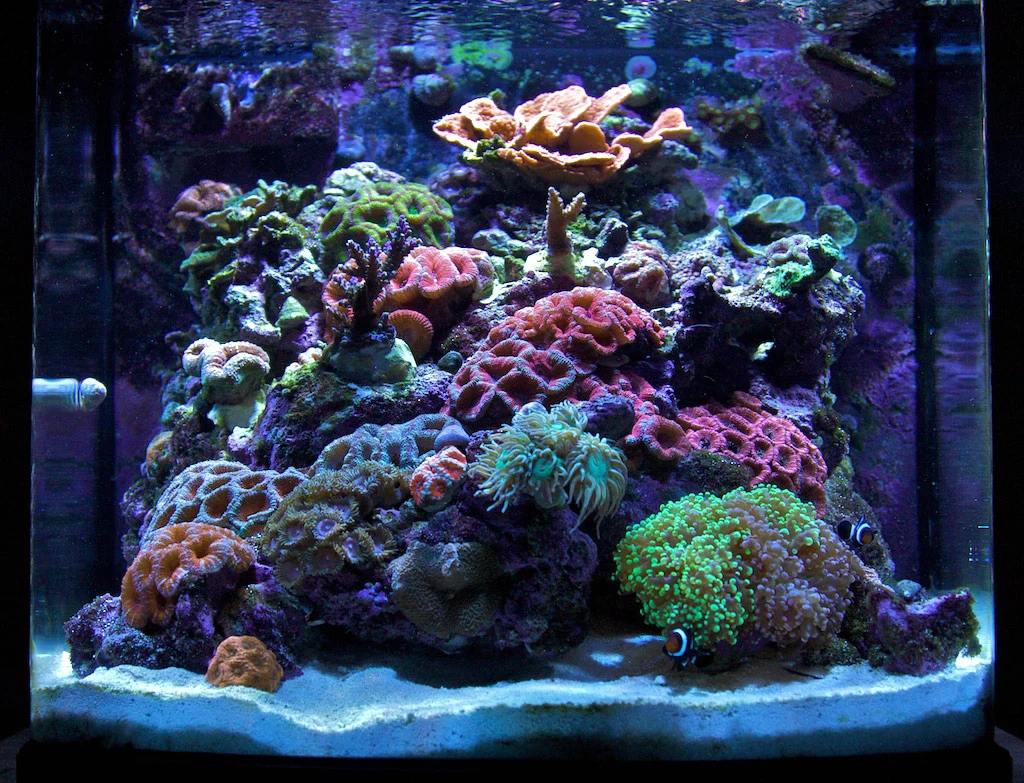Stunning 24-Gallon Reef Tank – Mini_GBR's TOTM | NanoReef

Tank Specifications
Volume: 24 Gallons / 90 Liters
Dimensions (L × W × H):
18.0" ×
19.7" ×
19.6"
45.7cm ×
50.0cm ×
49.8cm
Equipment List
- Salt: RO/DI unit
Frequently Asked Questions
How do I maintain water quality in my reef tank?
To maintain water quality, regularly test and monitor key parameters such as pH (ideally around 8.0), calcium (460-500 ppm), alkalinity (9 dKH), magnesium (1200 ppm), nitrates (keep below 5), and specific gravity (1.026 sg). Change 5 gallons of mixed water weekly and replace filter floss in the filtration system.
What is the daily routine for my reef tank?
A typical daily routine includes: Turn on wave maker pumps at 8 AM, skimmer at 10 AM, and main light (Sunpod) at 11 AM. Turn off wave maker at 11:45 PM, skimmer at 4 PM, and main light at 11 PM. Blue moonlights turn on at 11 PM and off at 1:30 AM.
How do I prevent algae growth in my tank?
Regular maintenance is key to preventing algae. This includes utilizing a cleanup crew for algae consumption, blowing settled detritus off live rock using a turkey baster during weekly maintenance, and ensuring proper water circulation. Additionally, keep nitrates low (below 5) and ensure good light management.
What do I feed my fish and corals?
Feed fish occasionally with freeze-dried cyclop-eeze and generic pellet food. Corals benefit from Reef Nutrition Oyster Feast once a week, and LPS corals receive a mixture of frozen chopped shrimp and other coral food about once or twice a month, using spot feeding techniques to minimize waste.
How do I manage coral growth in my reef tank?
To manage coral growth, introduce new corals slowly to provide adequate space as they develop. Use rubble rock to allow for easier frags as corals grow larger, and be ready to thin out colonies by trading, selling, or giving away excess frags when necessary.
What types of fish and invertebrates work well together in a reef tank?
In this tank, compatible fish include Ocellaris clownfish and goby-pistol shrimp pairs. For invertebrates, consider a variety of snails (e.g., Margarita, Cerithium, Astrea) and hermit crabs, which help maintain a clean tank environment.
How do I choose lighting for my reef tank?
Choosing lighting, like the Current USA Sunpod HQI MH 150w with a 14K Phoenix bulb, is crucial. Aim for high output lighting that simulates natural light conditions, especially for SPS which require high light levels. Also, consider transitioning to LED systems in the future for energy efficiency and better coral growth.
What filtration system is recommended for a reef tank?
A combination of live rock (with rubble), activated carbon, and a quality skimmer can effectively filter a reef tank. Having 40 lbs of live rock and using products like Chemipure Elite and filter floss are good practices. Cleaning and maintaining these will keep the system more stable.
How can I automate the care of my reef tank?
Automating your reef tank can be achieved through the use of controllers (like the Digital Aquatics Reef Keeper), auto top-off systems for maintaining water levels, and automated dosing systems for alk and calcium. Planning hardware placement from the start will help in creating a more consistent environment.
What should I do if my tank overflows?
Ensure all anti-siphon valves are installed correctly on your ATO water pipes to prevent back siphoning. Regularly check ATO levels and maintain your equipment to avoid overflow incidents.
How do I handle rapid growth in SPS corals?
When SPS growth becomes excessive, frag the colonies before they shadow other corals. Set up trades with local fish stores or community members to share surplus frags. Always monitor light levels, as excessive growth can block light for other corals.
What if my soft corals are not thriving?
If soft corals, such as zoanthids, struggle, evaluate your light levels, flow rates, and nutrient levels as this system has been noted to favor SPS and LPS corals. Adjusting parameters may be necessary, and you might consider focusing on the types of corals that suit your tank's environment.